Roundabouts (a.k.a. traffic circles) as traffic-calming tools in residential neighborhoods are relatively common in Portland. You might have seen them in the Ladd’s Addition neighborhood or on Northeast Tillamook or Northwest Raleigh streets, just to name a few. Our transportation bureau has even built bicycle-specific roundabouts on NE 21st and SE Milwaukie.
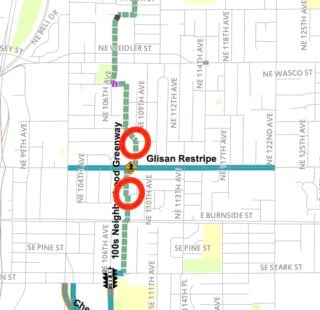
The latest additions are three new roundabouts on NE 108th Avenue that showed up late last year as the 100s Neighborhood Greenway project. That greenway is part of PBOT’s $11 million East Portland Access to Employment and Education project which broke ground in December 2020 and is a suite of five separate projects that aim to make it easier and safer to bike and walk through neighborhoods east of I-205 between I-84 and Powell Blvd.
Over the weekend I took a closer look at the new roundabout at NE 108th and Oregon and the new “double mini roundabout” at 108th and Everett (that we last reported on back in March 2021). What I learned is that results so far have been mixed.
Advertisement
Between Burnside and the protected Halsey-Weidler bike lane couplet, the 100s Neighborhood Greenway uses 108th. At Oregon and Everett there’s a three-pronged diagonal and an off-set intersection respectively. To better manage automobile traffic through these intersections, PBOT has removed stop signs and added concrete roundabouts.
At Oregon St (above) the curve in 108th creates an intersection that is about 70 feet at its widest point. That’s very wide for a residential area where streets that lead into the intersection are just 25 feet wide. As you can see, the roundabout takes up the vast majority of the space and leaves just a narrow lane for drivers. The concrete has a very low profile and the curbs are barely curbs at all, which means it’s easy to drive up onto the roundabout. Most people seemed to have no trouble driving around this one and it appears to be working well. (Despite this, one homeowner yelled at me from her porch that the roundabout was “an intrusion that no one wanted” and that she has trouble seeing it at night.)
The double mini roundabout at Everett is an entirely different story.
Advertisement
As you can see in the video, most people don’t obey the roundabout rules — and it’s hard to blame some of them. The off-set nature of the street and the size of the concrete circles leaves very little room to navigate a car around. If you’re in a big truck or a bus, it’s impossible to obey the rules. Making matters worse at Everett are the unpaved shoulders, which many people end up driving on just to make the turns.
Another big issue I came across on Everett is how the roundabouts impact the safety of people not in cars. Because the remaining paved street space is so minimal, drivers and walkers are now more likely to share the same lane. This leads to stressful and potentially dangerous interactions. Combine this with the completely unpredictable behavior of drivers as plow right over the medians and the lack of sidewalks, and you have problems.
A quick-and-easy possible fix would be to pave a bit more of the right-of-way to give folks on foot and behind the wheel as much room as possible to squeeze by.
On the bright side, both these installations appear to slow down drivers. Once PBOT finishes other elements of this project, like a new signal and crossing enhancement on nearby Glisan, biking will really improve in this area.
Speaking of PBOT, I asked them if these roundabout projects were complete. Interim Director of Communications and Public Involvement Hannah Schafer said there’s still some work ahead, “including some centerline hardening that will make it more difficult for people to go around the wrong way”. But that work won’t happen until later this spring because the contractor is on hiatus for the winter.
We’ll keep watching these intersections to see how or if they change in the coming months.
Have you used either of these? What do you think?


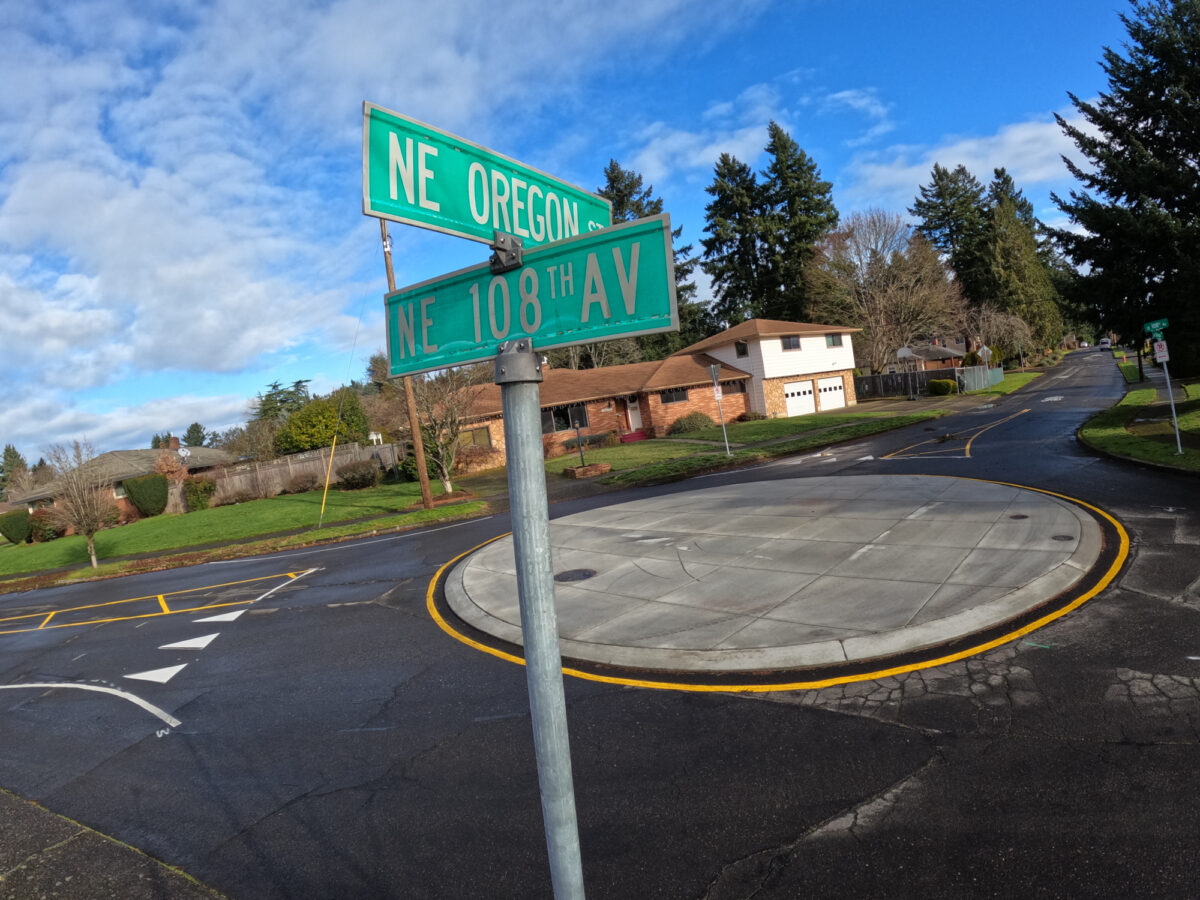
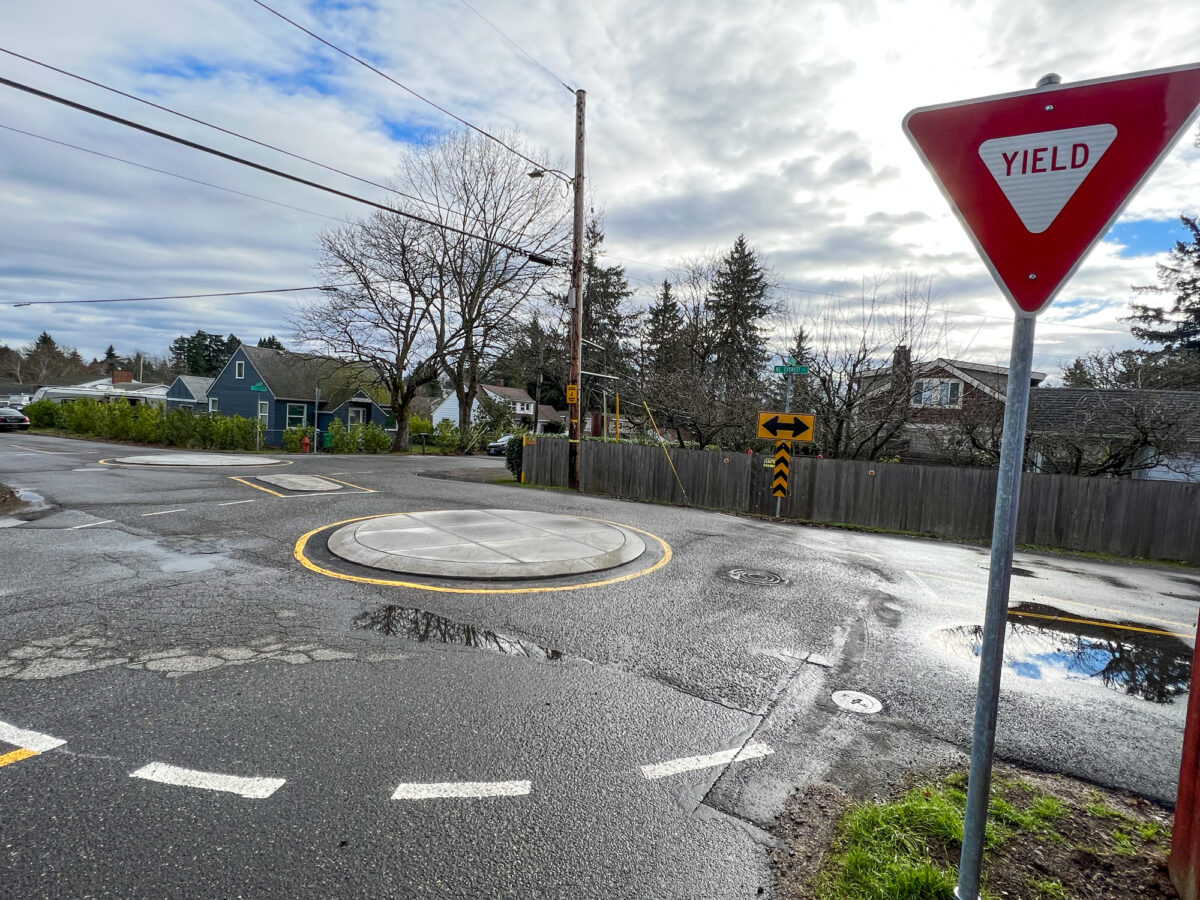
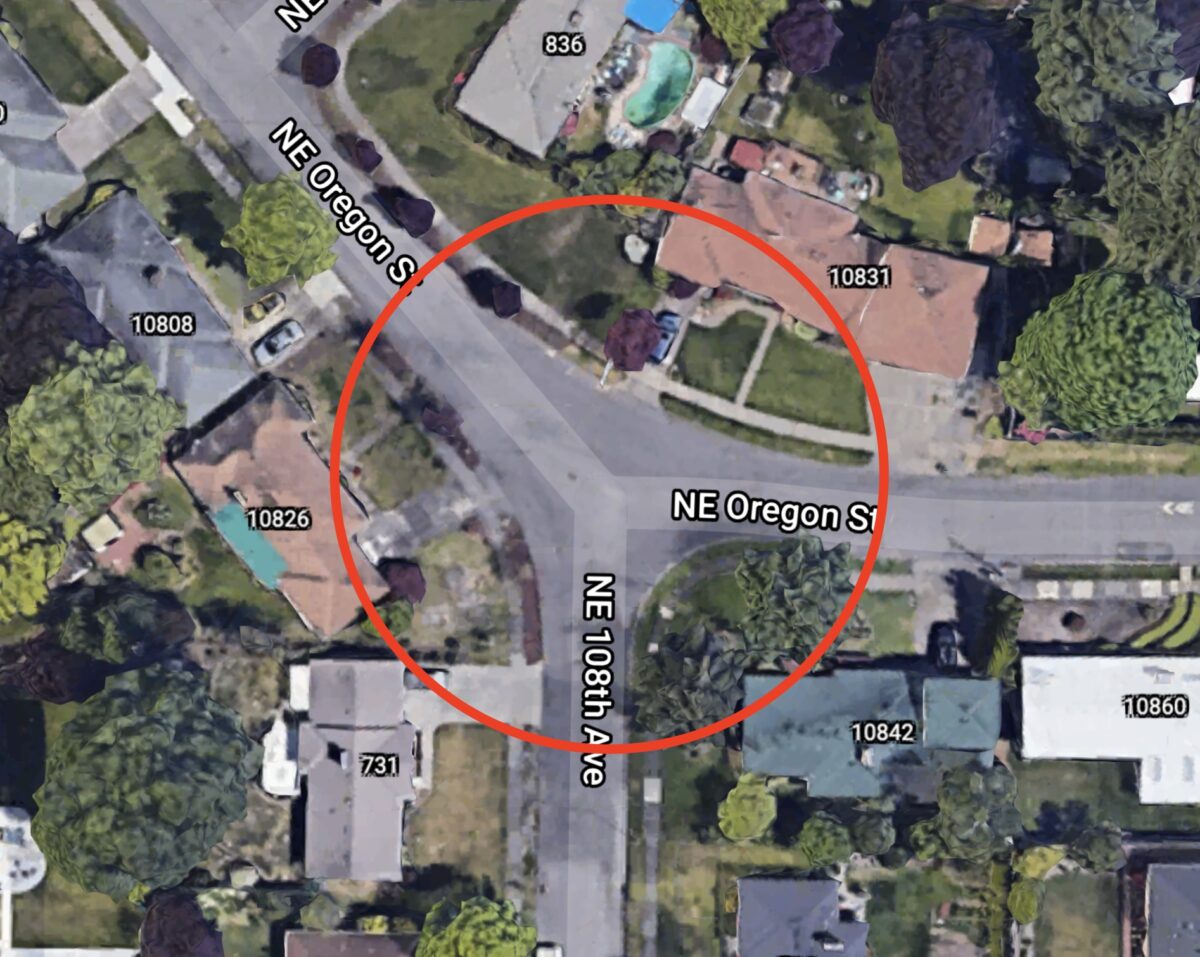
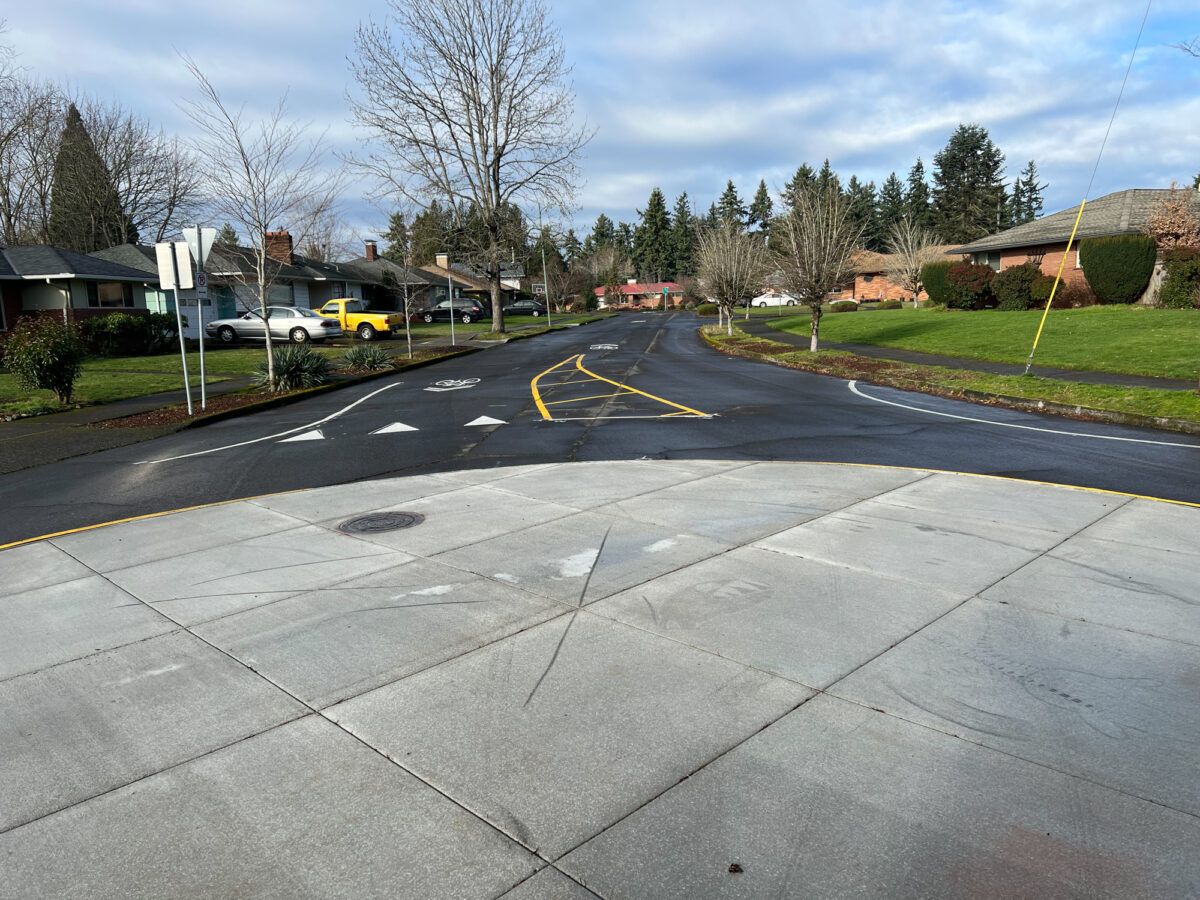
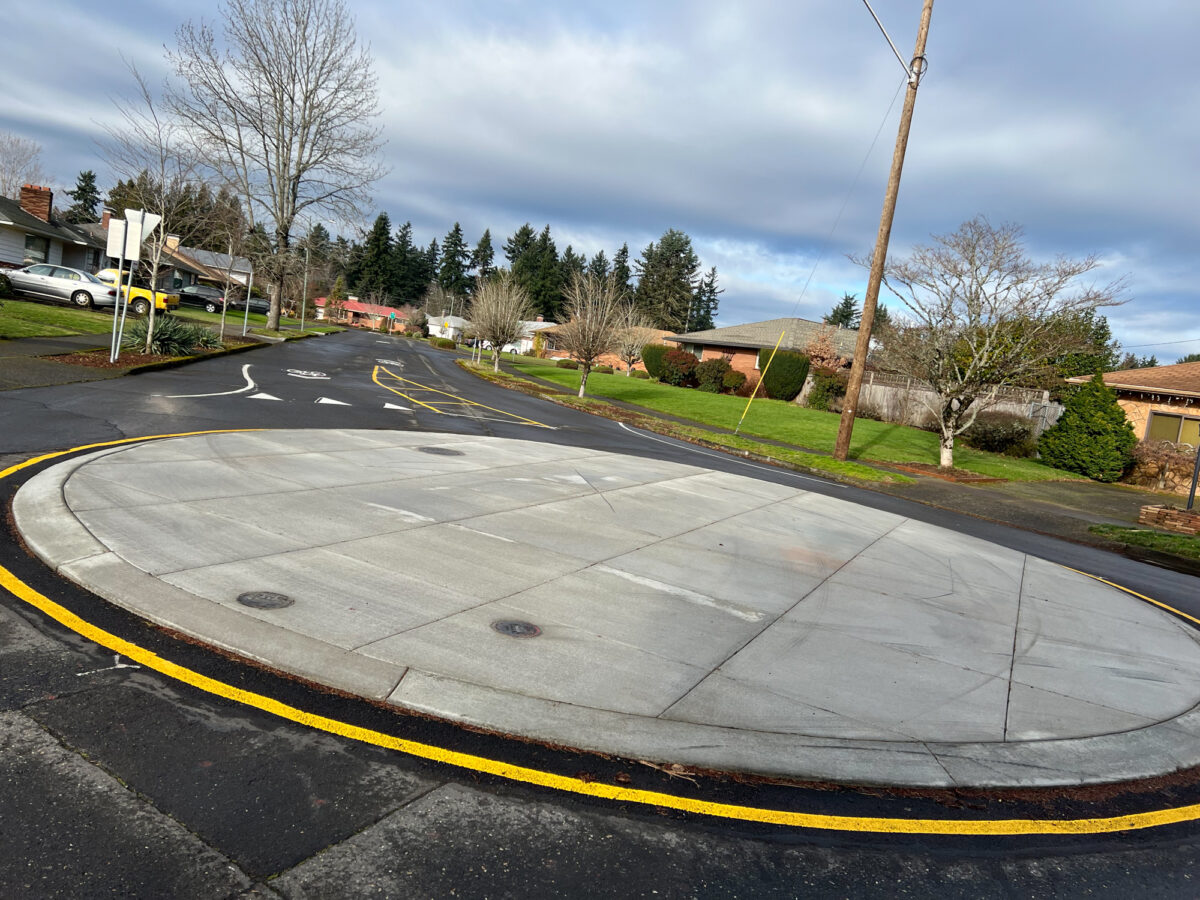
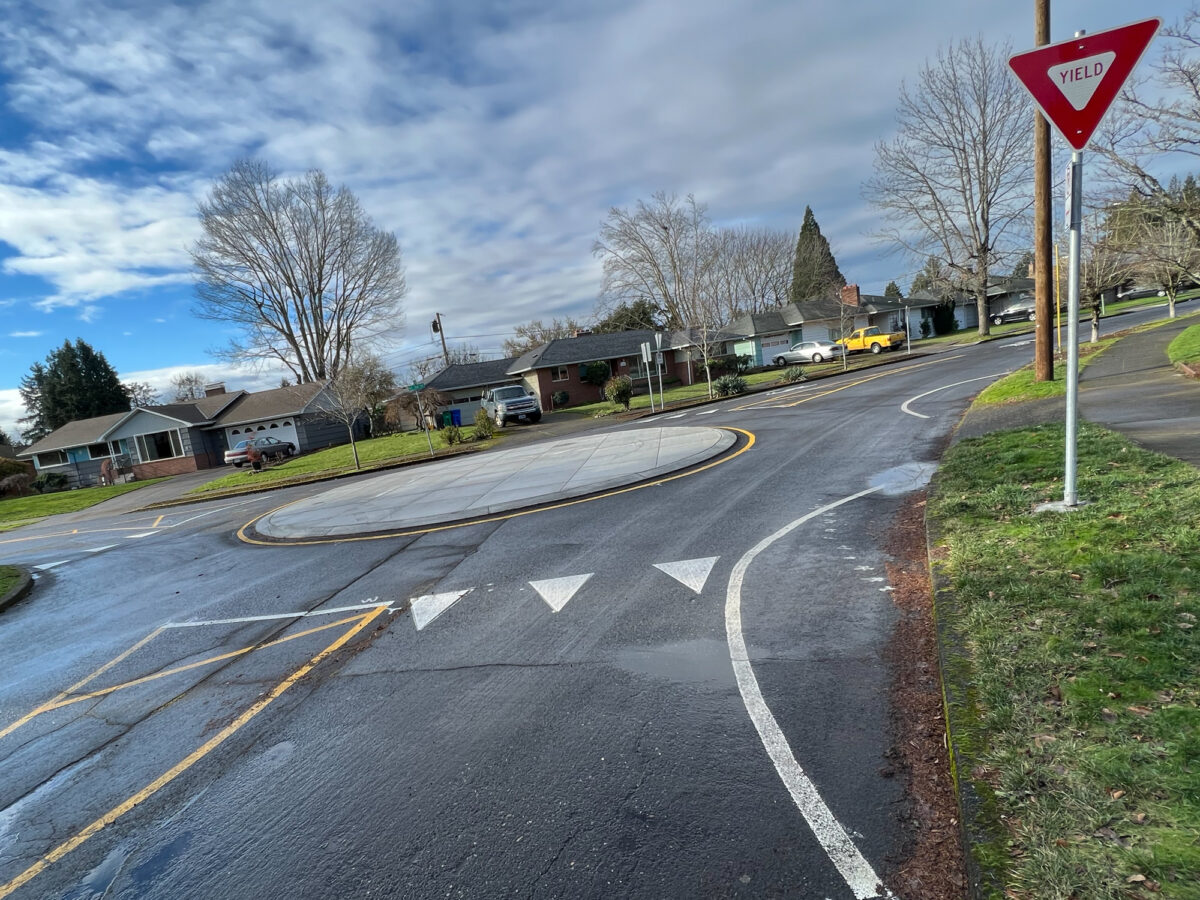
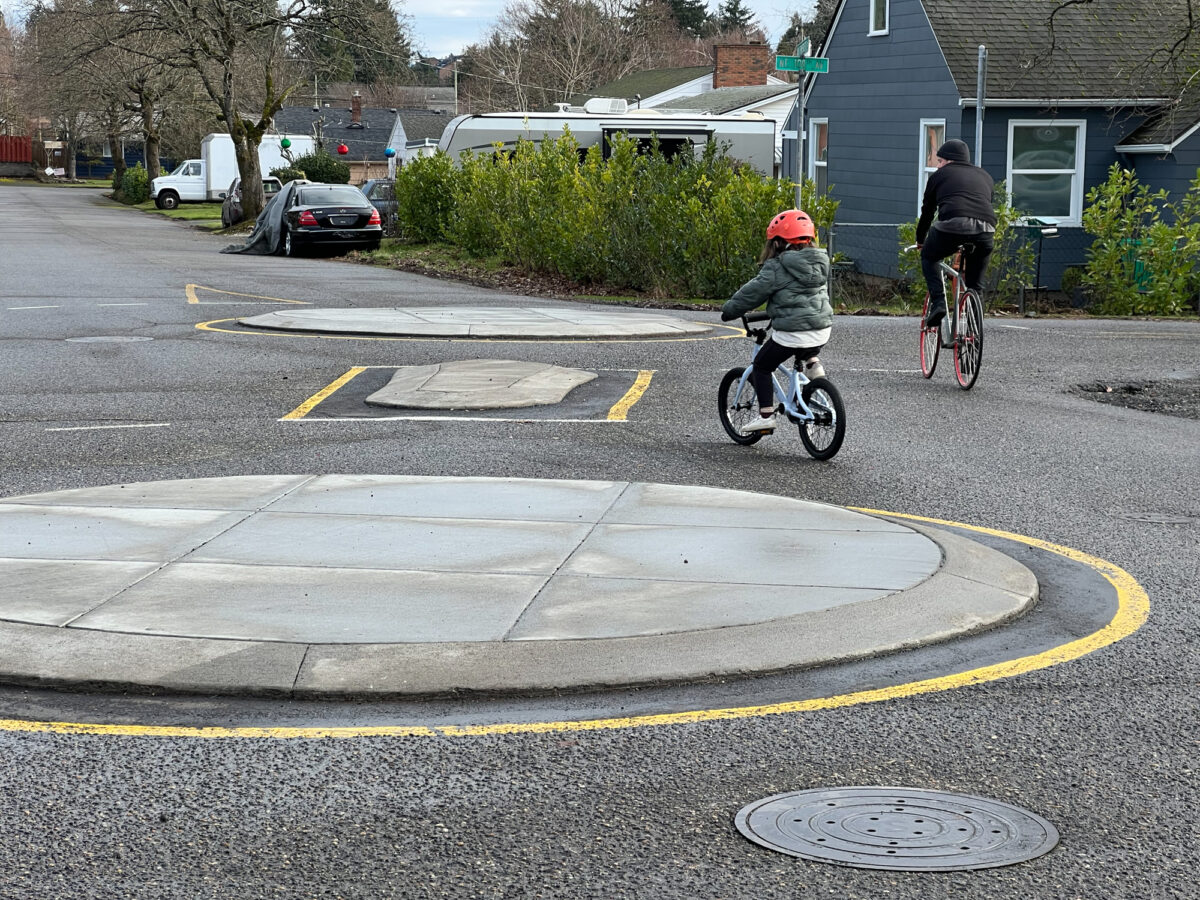
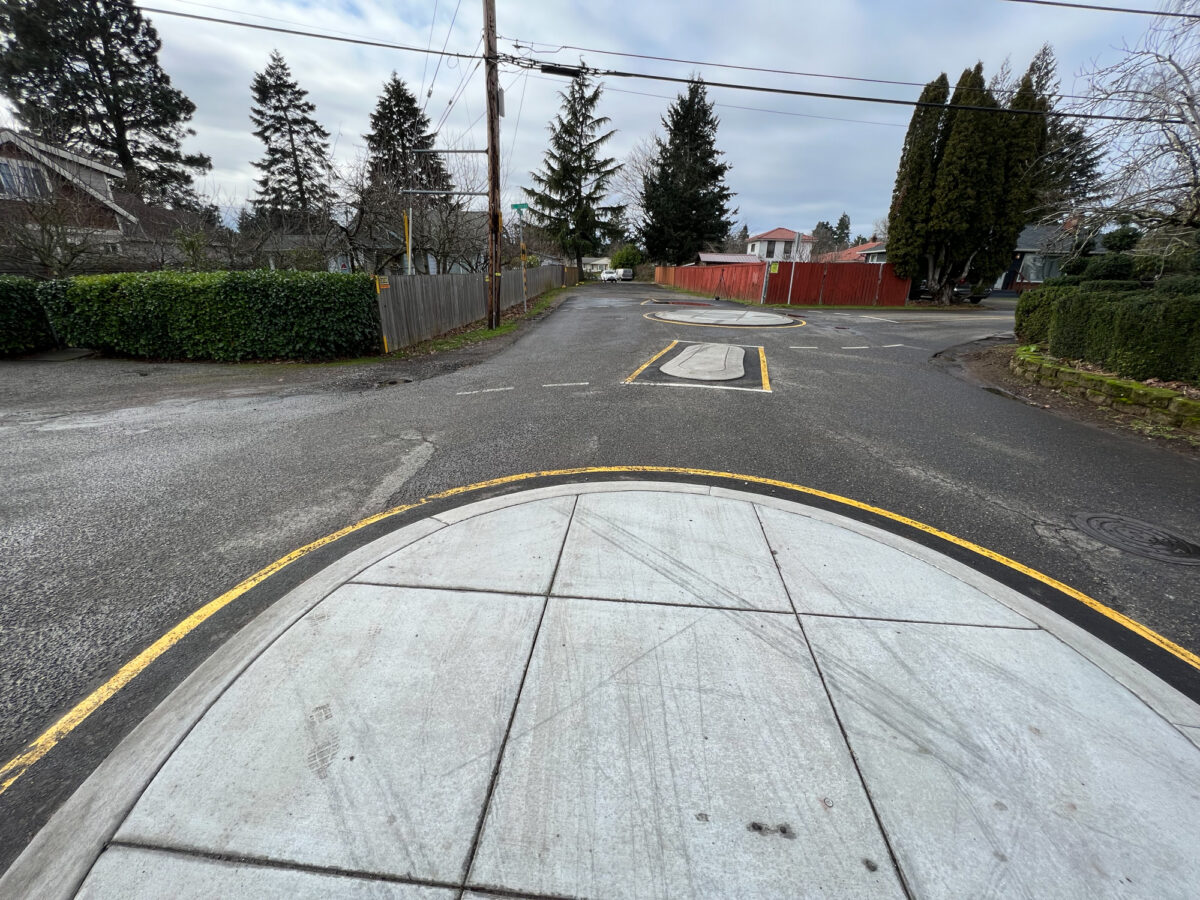

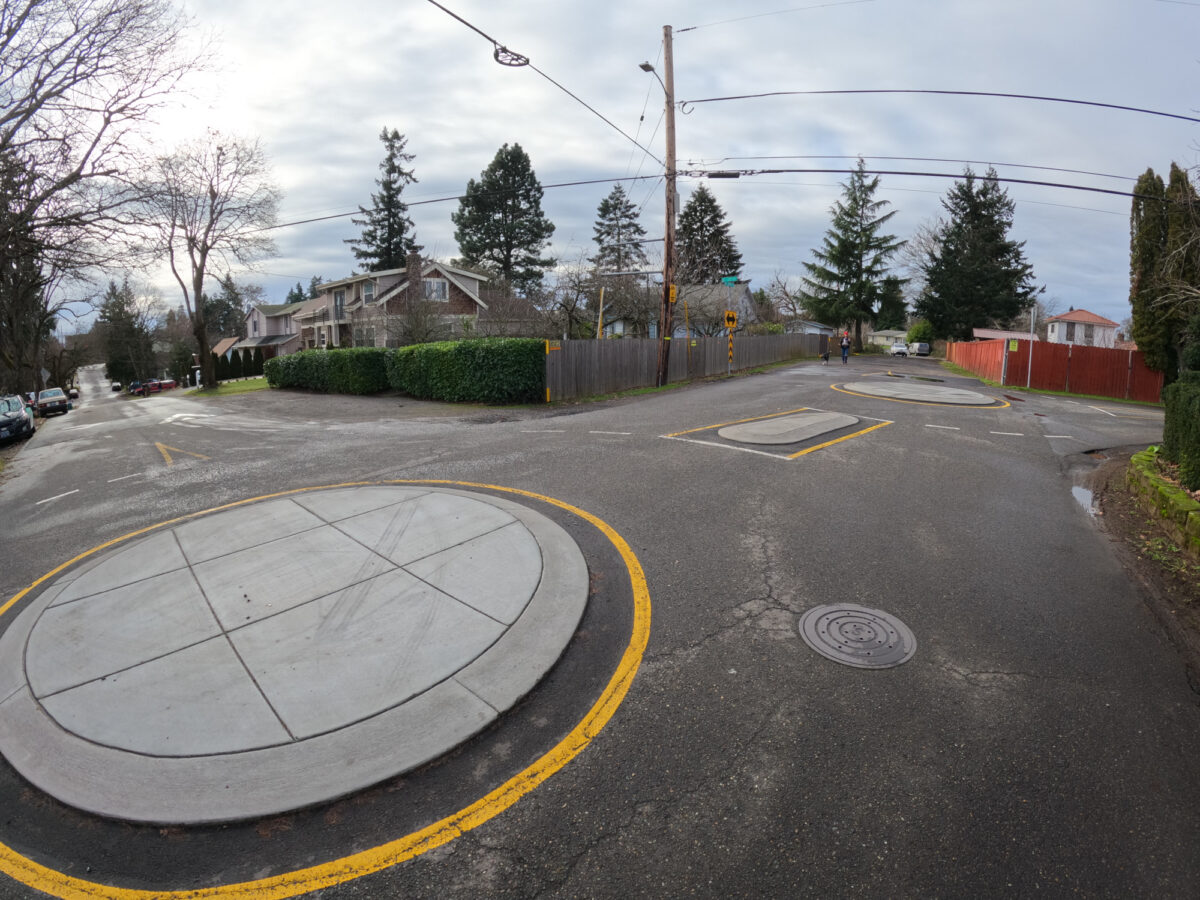
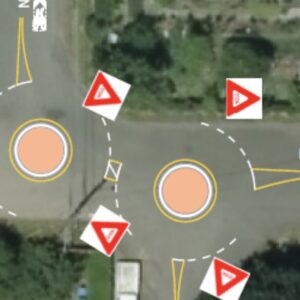
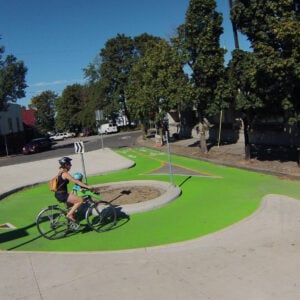
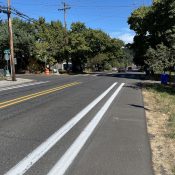
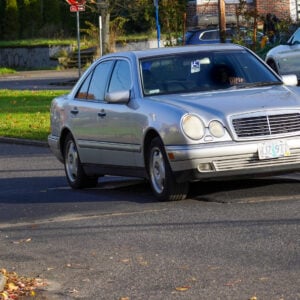
Thanks for reading.
BikePortland has served this community with independent community journalism since 2005. We rely on subscriptions from readers like you to survive. Your financial support is vital in keeping this valuable resource alive and well.
Please subscribe today to strengthen and expand our work.
I appreciate the focus in the article and especially the video about how these work (or don’t) for people walking.
With no roundabouts, vehicles could stay in the middle of the street, leaving the edges for people walking. With them, vehicles are forced to the edge of the street, and people walking are forced off the pavement and into the mud if they don’t want to be run over.
It’s such a contrast to the recently reviewed Lincoln/Harrison changes, which took the opposite approach (I know the situations are different) of widening the pedestrian edges by pushing vehicles INTO the center of the road. That one looked like designers gave some thought to people walking along and across the streets.
Your comment about this functioning differently in real life than how it may have looked on a drawing seems to sum it up perfectly.
I’m a bit surprised that PBOT would install these projects in concrete before piloting something less concrete to see how they work (especially the double roundabouts). Also surprised that there is no signage indicating the direction of traffic flow which seems standard for many of the roundabouts I’ve seen around town; perhaps signage is part of the finishing work to be done?
That’s too bad that the two circles at Everett missed the mark. Good infrastructure should be intuitive for all users and now the confusion makes it hard for vulnerable road users to anticipate what a driver is going to do. I find myself wondering how a simple round concrete planter, like the ones recently added on the greenways, placed in the location of that center rectangular curb would perform in comparison. I feel like it would have slowed down the traffic, kept the logic of a roundabout (a center of the road obstruction), and not pushed vehicles as far into the pedestrian zone as this new treatment seems to.
Slower drivers is always a good thing.
“Slower drivers is always a good thing” isn’t true, and it misses the point of Zach’s post.
Zach suggested an alternative design to slow traffic while reducing two negative aspects of PBOT’s design that several people (including the neighbor in the video) have mentioned–that PBOT’s design forces vehicles far into the pedestrian zone, and (as you also mentioned) made turns so tight that many vehicles (in your own words, “think garbage trucks, delivery vehicles, the person with a boat or trailer, moving and delivery vans”) end up driving the wrong way head on into the path of people who drive correctly around the circles.
PBOT’s design does slow traffic, but at the cost of creating those dangerous outcomes. Zach’s proposal may have issues of its own, but I’d hate to think that PBOT is satisfied with how this one works, or that PBOT shares your view that slowing drivers is a good thing even when it creates other significant dangers.
Do they make them so easy to drive over for emergency vehicles? I can imagine most vehicles are able to just drive over them like most people do to the round abouts in Bend.
Fire trucks are not the only trucks that need to access the neighborhood. Mini-roundabouts are designed to be driven over by larger vehicles, think garbage trucks, delivery vehicles, the person with a boat or trailer, moving and delivery vans.
I feel a certain irrational responsibility for the fixes at 108th & Everett. During the EPIM process (2010-2012) when we were designing the 100s bikeway, I made some vague suggestions to PBOT staff that they look into traffic circles there. I regularly passed through there between my townhouse at SE 105th & Pine and the EPCO offices at 117th & Pacific (on the HOP). It is a poorly designed and long neglected piece of broken infrastructure that needed a lot of love. Even in 2010 cars would go flying through there while kids would play on the street nearby, so I’m really glad they are now experimenting with various improvements there.
The video is very helpful. Given the mess that is East Portland, IMO these pieces of infrastructure work really quite well by confusing all users equally, particularly fast drivers, as everyone slows way down to navigate the mess. The mountable curbs are only mountable at slow speeds – any vehicle going over 45 is going to get some damage. The potholes are a nice touch.
NE Oregon & 108th is where two greenways meet – the 100s and the HOP – so I’m glad they maximized the traffic circle radius there.
Serious question; what are we paying PBoT for?
Almost every new project somehow manages to be simultaneously too much and yet not enough. They do a horrible job maintaining and managing roads and bike lanes. Even glitzy new projects are forgotten and left to descend into negligent decay nearly as fast as they are completed.
It seems like their core competency is holding meetings and pushing out cutesy advertising collateral. I would imagine the department is chock full of fresh faced masters-educated best and brightest who have pilgrimaged to hollowed land of Portlandia in the hopes of creating utopia when instead they are making a mess.
I predict in ten years we are going to be tearing all this crap out and doing it right. A waste of time and resources.
You’re not really paying PBOT much of anything. Your critiques focus on maintenance, but I suspect you’d also complain if nothing new was ever built, i.e., all revenues spent on just maintenance. Start a lobby to double the budget, see how far you get.
Pbots motto could be “no half measure left behind in the drawer of bad ideas”
Another POS ‘experimental’ installation by PBOT, is anyone surprised??!??
This belongs in a museum of the absurd, and not out on the street!
Not that you know much about road design…
Mini roundabouts are less common in North America, but frequently used in the UK. Their footprint is smaller, making them suitable for retrofit situations with right of way constraints (and lower cost). They are also commonly used where truck U-turns are not needed, so achieve all the safety benefits of compact modern roundabouts at a much lower cost. They are all truck apron, and in the UK are sometimes just paint on the road.
These are a hazard to cyclists, period.
Mountable curbs ARE safer for cyclists; that’s not what makes the design absurd.
Heavy Sigh….
On one hand I’m grateful for the 100,s finally starting to be built after being funded for almost 8 years.
On the other hand, it won’t be connected to the Bush greenway until Outer Powell Blvd. is completed at the southern end. 2025 to be exact.
I’d encourage folks to ride this route and see some of the other improvements to the north around Halsey.
This route will connect you to The Outer Rim bike shop on Halsey and 106th. They moved across street. This is the only bike shop east of I-205.
I’ve been riding this route, or parts of it, for 15 years. Thank you PBOT.
A missed opportunity to put plants in the center – so much ugly paving.
Thanks for the video Jonathon. You’ll notice the difference between the 2 projects as there are no paved shoulders, or sidewalks on Everett. East Portland has many contrasting neighborhoods like this making it very difficult to design projects that are fluid and intuitive for all modes. Thanks PBOT.
Wow, can’t PBOT ever be consistent in what they do? It’s almost as if every engineer does their own thing, that ever project is an “experiment.” Of course when it’s a failure they can just point out that is was an “experiment” and shrug their shoulders.
We send these people, though admittedly mostly politicians and higher ups, on expensive vacation junkets to Europe to see how they do things and yet, have they EVER implemented any European ideas? Or is it once again, come back, form a committee, and take 2 – 3 years to come to a consensus?
I moved to Portland back in the 80s and to my naive eyes I thought it was a great town. But, boy, the past 5 – 10 years has really opened my eyes at how dysfunctional Portland really is and that is very sad.
slack jaw, not saying much. It appears you have no actual road design experience since none of your critique points to any technical flaws. BTW, mini-roundabouts are quite common in Europe, sometimes just paint on the ground.
Obviously, you have a stake in designing and installing this kind of crap.
A person doens’t have road design expert to recognize garbage whether it be these lame roundabouts or other dubious designs coming out of PBOT.
After spending time in Europe on our dime, I would expect PBOT would finish the project with sidewalks, or some ADA ramps. East Portland is not Europe, design for it. Better luck next project.
As far as inner Portland is concerned, East Portland* might as well be Europe.
*especially Portland East of 205
I just read your earlier article about this, which includes a conceptual drawing of the Everett circles:
https://bikeportland.org/2021/03/25/an-east-portland-greenway-will-get-citys-first-double-mini-roundabout-329212
Two things strike me: First, even in the concept sketch, it’s clear how vehicles are forced so far to the edge of the street that there’s no room for people walking. Second, the comments predict exactly the same problems that you and the neighbor mention in the video about drivers not going through correctly, and conflicts with pedestrians. I wanted to mention some of the most prescient commenters, but there are too many.
If you can drive over it, it is t a roundabout.
Ya need more room for these to be effective and safe. 2 little concrete buttons in the middle of an intersection + a 35mph jeep with off-road tyres = it smacks right into the sidewalk. C’mon PBOT, do it right, get some eminent domain to chew a bit from the adjoining properties and do one proper roundabout. And add more lights and signs while you’re at it, like they do it in Europe!